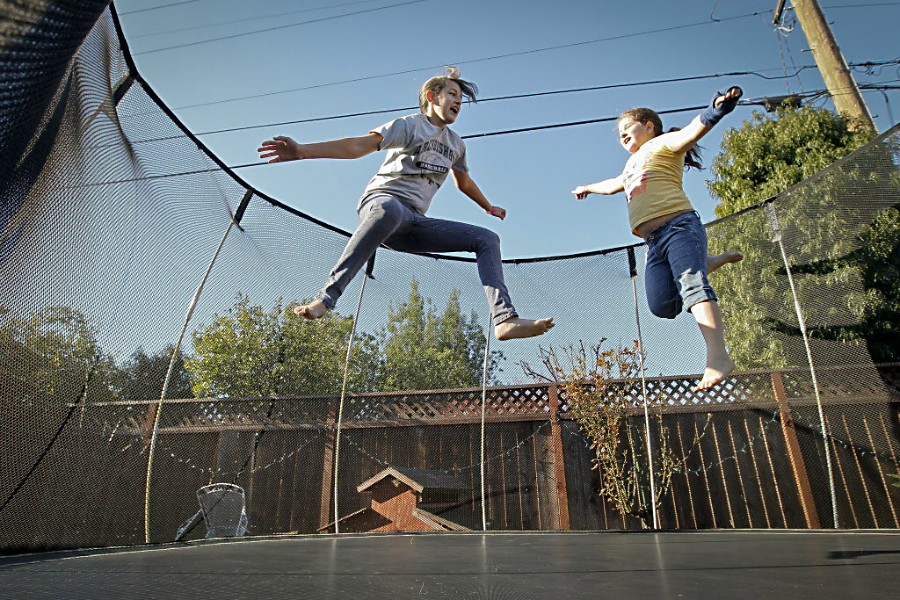Trampoline injuries soar sky high: Are more regulations needed?
Loading...
Trampoline parks – indoor arenas covered wall-to-wall in spongy surfaces to bounce, somersault, and flip off of – have jumped in popularity since 2010. But a study published Monday in the journal Pediatrics has found that trampoline injuries have risen as well.
Visits to US emergency rooms for injuries from trampoline parks have increased 12-fold from 2010 to 2014, according to an analysis of the government injury surveillance system conducted by researchers at the Connecticut Children’s Medical Center in Hartford.
These results have resurfaced questions about whether the indoor attractions require more regulations.
There are no federal regulations for trampoline parks. Only Arizona and Michigan have specific safety laws, according to WNCN, the CBS affiliate in Goldsboro, N.C., and other efforts have fallen short. Maureen Kerley, whose 30-year-old son was killed when he somersaulted into a foam pit in a Phoenix trampoline park, demanded federal standards after she successfully lobbied Arizona to adopt Ty’s Law in honor of her son. A measure in Georgia that would have required minimum standards for the operation of trampoline parks failed in 2015, according to The Augusta Chronicle.
The rest of the country must rely on industry safety guidelines recommended by the International Association of Trampoline Parks (IATP). One of IATP's board members, Ed Reed, told The Augusta Chronicle the guidelines are “more prescriptive” in order to protect customers.
The IATP recommends a minimum ceiling height, and suggests trampolines be a certain distance from the floor. It also recommends a trampoline be contained with Plexiglas walls or no-hole netting, have a dismount area clear of obstructions, and have any hard framing covered by foam padding. The IATP also insists only one person should be jumping for every 60 feet of trampoline, and there be one court monitor for every 32 guests.
The association estimates there are 50 million visits to trampoline parks in the United States each year.
These visits come as the number of trampoline parks soared. In 2010, there were about 25 parks. By 2014, there were 10 times as many. That growth has continued in the last two years, with 460 parks in North America in 2015, and another 220 around the globe, according IATP.
With this growth came more than 6,000 more trips to the emergency room, Monday's study found. There were 6,932 ER visits in 2014 for injuries from trampoline parks, compared to 581 in 2010, according to the study. Injuries included broken legs, neck sprains, and concussions, but 90 percent of the injured children and adults were treated and released.
Most trampoline injuries, the study notes, occur at home, not in indoor parks. Each of the five years studied, the number of ER visits from home trampoline injuries was just over 90,000.
The American Academy of Pediatrics (AAP) has long cautioned against children playing on any trampolines, at home or at parks. In a statement Monday, it wrote that if trampolines are used, the AAP recommends constant adult supervision, adequate protective padding, one jumper per trampoline at any one time, and no flips or somersaults.
The IATP was critical of Monday’s study and the AAP's response. In a statement, it emphasized the rate of injuries was bound to increase with more visits to trampoline parks. However, it noted the injury rate at trampoline parks is much less than the injury rate among high school football players, as an example.
"Football players experience injuries at a rate of 3.87 per 1,000 exposures," wrote the IATP, in a statement. "The rate of reportable injury at a typical trampoline park is less than one per 10,000 jumpers."
The IATP said it agreed with APP in advocating supervision and protecting padding, and supports increased guidelines. It also said it supports more investigations into strategies to prevent injury at trampoline parks and on home trampolines "where guidelines ... are neither as rigid nor effective as those in parks where activities are organized and supervised."
"We believe that the positives of youth recreational sports far outweigh the negatives and we are actively engaged in programs aimed at promoting the safety and well-being of jumpers who visit our member parks," it wrote.
This report contains material from the Associated Press.





